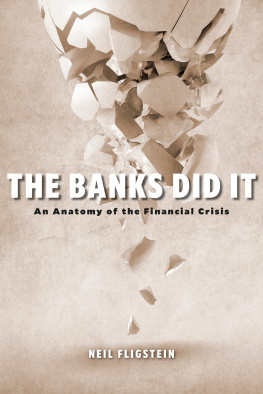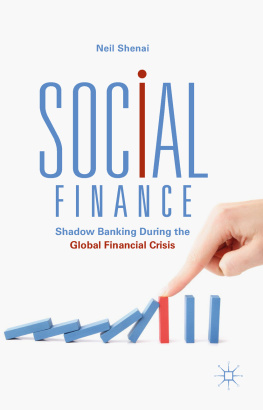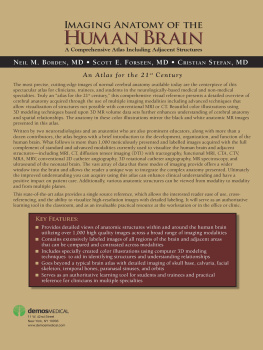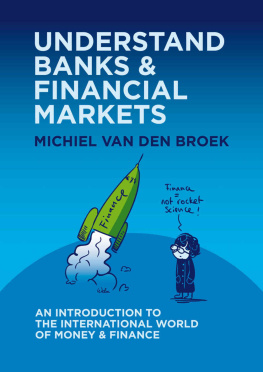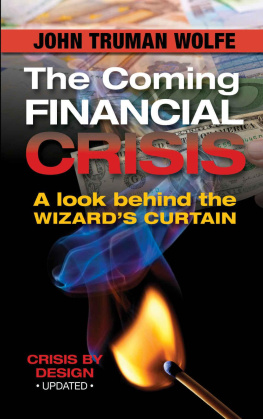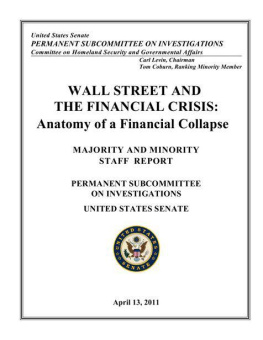Neil Fligstein - The Banks Did It : An Anatomy of the Financial Crisis
Here you can read online Neil Fligstein - The Banks Did It : An Anatomy of the Financial Crisis full text of the book (entire story) in english for free. Download pdf and epub, get meaning, cover and reviews about this ebook. year: 2021, publisher: Harvard University Press, genre: Business. Description of the work, (preface) as well as reviews are available. Best literature library LitArk.com created for fans of good reading and offers a wide selection of genres:
Romance novel
Science fiction
Adventure
Detective
Science
History
Home and family
Prose
Art
Politics
Computer
Non-fiction
Religion
Business
Children
Humor
Choose a favorite category and find really read worthwhile books. Enjoy immersion in the world of imagination, feel the emotions of the characters or learn something new for yourself, make an fascinating discovery.
- Book:The Banks Did It : An Anatomy of the Financial Crisis
- Author:
- Publisher:Harvard University Press
- Genre:
- Year:2021
- Rating:5 / 5
- Favourites:Add to favourites
- Your mark:
- 100
- 1
- 2
- 3
- 4
- 5
The Banks Did It : An Anatomy of the Financial Crisis: summary, description and annotation
We offer to read an annotation, description, summary or preface (depends on what the author of the book "The Banks Did It : An Anatomy of the Financial Crisis" wrote himself). If you haven't found the necessary information about the book — write in the comments, we will try to find it.
The Banks Did It : An Anatomy of the Financial Crisis — read online for free the complete book (whole text) full work
Below is the text of the book, divided by pages. System saving the place of the last page read, allows you to conveniently read the book "The Banks Did It : An Anatomy of the Financial Crisis" online for free, without having to search again every time where you left off. Put a bookmark, and you can go to the page where you finished reading at any time.
Font size:
Interval:
Bookmark:
Contents

THE BANKS DID IT
THE BANKS DID IT
An Anatomy of the Financial Crisis
NEIL FLIGSTEIN
Harvard University Press
CAMBRIDGE, MASSACHUSETTS
LONDON, ENGLAND
2021
Copyright 2021 by the President and Fellows of Harvard College
All rights reserved
Printed in the United States of America
First printing
Library of Congress Cataloging-in-Publication Data
Names: Fligstein, Neil, author.
Title: The banks did it : an anatomy of the financial crisis / [Neil Fligstein] Description: Cambridge, Massachusetts : Harvard University Press, 2021. |
Includes bibliographical references and index.
Identifiers: LCCN 2020050258 | ISBN 9780674249356 (cloth)
Subjects: LCSH: Financial crisesUnited StatesHistory21st century. | Banks and bankingUnited StatesHistory21st century. |
MortgagesUnited StatesHistory21st century. | Global Financial Crisis, 20082009.
Classification: LCC HB3725 .F55 2021 | DDC 330.973/0931dc23
LC record available at https://lccn.loc.gov/2020050258
For Heather
Contents
Figures
Tables
The financial crisis that began in the United States in 2007 created the most intense economic downturn in the United States since the Great Depression. The crisis not only engulfed the United States but also quickly spread to banks across western Europe. The ramifications of this crisis and the recession that followed are with us today. Not surprisingly, from the first moment of the crisis, scholars and journalists attempted to make sense of what happened. The search for the cause of the crisis brought about an avalanche of books and papers on the subject. Many were journalistic accounts, some were memoirs, and still others were books rushed to press by economists, political scientists, and sociologists. Andrew Lo, a financial economist, reviewed twenty-one of these books in 2012 and declared, No single narrative emerges from this broad and often contradictory collection of interpretations, but the sheer variety of conclusions is informative, and underscores the desperate need for the economics profession to establish a single set of facts from which more accurate inferences and narratives can be constructed (Lo, 2012).
Unfortunately, many years on, we are not anywhere near a single set of facts, nor is it clear what those facts might be. The causes of the crisis include a great many contradictory things. Some have argued that government regulation caused the crisis by forcing banks and the government-sponsored enterprises to make subprime loans to poor people (Wallison, 2015). Others have argued that too little government regulation permitted the banks to take on too much risk (which is at least part of the theory of the Dodd-Frank Act) (Acharya et al., 2009). Still others have argued that there was regulatory capture of the Federal Reserve, the Treasury Department, and the Securities and Exchange Commission. Bankers could do whatever they wanted while regulators cheered them on (Johnson and Kwak, 2010). Others blamed the real estate bubble whereby consumers and speculators drove up the price of housing to unreasonable levels (Schiller, 2015). The crash of prices was inevitable, and that crash, when it came, precipitated the crisis.
One of the original and more sophisticated stories focused on the chain of firms involved in the sale of mortgages to homeowners, the packaging of these mortgages into securities, and the sale of securities to investors. This theory suggested that perverse incentives existed such that those banks who originated risky mortgages passed on those risks to unwitting investors. The banks did not care if the loans were bad because they had no intention of holding on to them (Ashcraft and Schuermann, 2008). Other accounts favor blaming the complexity of the financial instruments: an insufficient understanding of the risks inherent in those instruments caused both investors and bankers to be too optimistic about the riskiness of the financial instruments being created (Furfine, 2014; MacKenzie, 2011). Another version of this argument holds that the credit rating agencies were similarly ill-informed and overly optimistic, thus rating too many mortgage-backed securities AAA (Rona-Tas and Hiss, 2010). This rating made those investments appear to be super safe and encouraged many investors to hold them.
Financial economists have focused on the moment whereby banks actually began to go out of business, beginning in the spring of 2007 when Bear Stearns defaulted on its loans. They interpret what happened as a lack of liquidity on the part of banks (Brunnermeier, 2009; Gorton, 2010). While the banks held significant investments, they were not able to sell them fast enough to provide additional cash to cover the money they had borrowed to buy them. When they tried to sell them, they found there was little market for them. The literature attributes this liquidity crisis to banks funding their long-term investments, like buying tranches of mortgage-backed securities, by using short-term loans. This argument has several variants, primarily focused on the organization of the repo market, the asset-backed commercial paper market, and the money markets, or what is collectively referred to as the shadow banking system.
One other explanation was to shift the blame to countries around the world who were running high positive current account balances, often because of the US chronic trade deficit. Foreign banks had cash to invest, and they chose to invest it either wittingly or unwittingly in American mortgages (the explanation proposed by no less a figure than Ben Bernanke, chair of the Federal Reserve Bank). This explanation implies that the housing bubble was caused by foreign banks that had to park their cash somewhere. In essence, this explanation neatly shifts the blame from Americans who took out those mortgages and American bankers who sold the mortgages and created and sold mortgage-backed securities to foreign banks. Those banks with so much cash to spend made cheap mortgages too attractive for unworthy home buyers to pass up and thereby pushed the housing bubble forward.
Finally, some have argued that the entire crisis was simply the result of the greed of bankers trying to make as much money as possible (Akerlof and Schiller, 2009). The sophisticated version of this argument focuses on executive and trader compensation. Here, the argument implies that bankers were rewarded most for making the risky deals by originating subprime mortgages and creating risky securities made up of these mortgages. Such deals paid off handsomely for the bankers, who generated high profits, but ended up putting the banks at long-term risk (Bhagat and Bolton, 2014; Crotty, 2009).
All of these explanations seem plausible. But they cant all be true. Part of the problem is that each explanation sets itself up as the one real cause of the crisis. It proceeds from the view that if the favored variable had somehow been recognized and changed, the entire crisis could have been averted. One of my advantages in having taken so long to work through the many elements of the crisis is that I have gotten some perspective on these events.
There have been two major problems with the literature as it has evolved so far. First, the banks have oddly not been a significant part of the story. Instead, the causal story has tended to focus on regulators, the individuals who bought mortgages, financial instruments, CEOs and traders, and capital flows. The firms that created modern finance and the many markets that made up the industry at its demise have rarely received sustained analysis. My purpose is to put the banks front and center in the analysis and show how they evolved, morphed into new markets, and took advantage of opportunities that barely existed even thirty years ago. The title of this book is
Next pageFont size:
Interval:
Bookmark:
Similar books «The Banks Did It : An Anatomy of the Financial Crisis»
Look at similar books to The Banks Did It : An Anatomy of the Financial Crisis. We have selected literature similar in name and meaning in the hope of providing readers with more options to find new, interesting, not yet read works.
Discussion, reviews of the book The Banks Did It : An Anatomy of the Financial Crisis and just readers' own opinions. Leave your comments, write what you think about the work, its meaning or the main characters. Specify what exactly you liked and what you didn't like, and why you think so.

